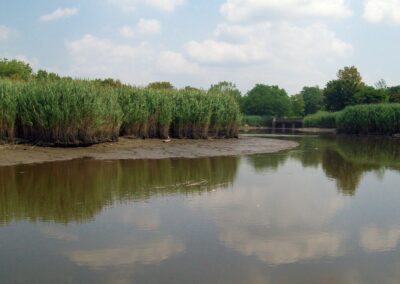Modeling
Models provide insight into physical and chemical systems. We build simple analytical models to drive science-based environmental decision-making. More sophisticated models are used to predict chemical fate and transport in groundwater or waterways, or via air dispersion. Our model visualizations include web site applications for real-time data presentation.
Groundwater
We use a range of analytical and numerical models to solve complex hydrogeological and geochemical problems. We project subsurface flow and chemical fate and transport, characterize historical and current groundwater flow paths, delineate plumes, and predict future chemical transport. Using robust, numerical modeling platforms, we bring a multidimensional analysis of groundwater flow and chemical transport to various remediation and litigation settings.
Saturated and Unsaturated Groundwater Flow | Multiphase Fluid Systems | Complex Bedrock Geology | Surface–Groundwater Interactions | Flow Systems with Variable Salinity and Temperature
Surface water
We apply our expertise in surface water modeling to predict flows, as well as sediment and contaminant fate and transport. Our analyses support water quality studies, NPDES compliance, allocation, site characterization, and remedial design. No matter what the need, we apply the model to get the job done right. From simple to complex, our models best integrate available data to meet project and client needs.
River and Estuarine Flow | Watershed Runoff | Sediment and Contaminant Fate and Transport | Water Quality | Thermal | Mixing | Compliance
oceanographic
Our site-specific oceanographic models support a wide variety of studies such as sediment and contaminant fate and transport, water quality and ecology, coastal resiliency, and offshore energy assessments. We develop state-of-the-science forecast, nowcast, and hindcast models that provide accurate 3-dimensional site conditions over a variety of spatial and temporal scales. Our oceanographic modelers have successfully completed projects nationwide and overseas in aquatic systems ranging from riverine, lacustrine, and estuarine environments to coastal waters and the deep ocean.
Hydrodynamics | Sediment Transport | Contaminant Fate and Transport | Water Quality | Ecology | Thermal Plumes | Coastal Resiliency | Coastal Adaptation | Offshore Energy | Marine Energy | Acoustics
air
To support compliance and permitting, we model air emissions from stationary and mobile sources, as well as fugitive emissions from soil or water. Using modeling output, we also perform direct (inhalation) and indirect (food chain) risk assessments. We use the regulatory suite of models to develop customized dispersion models for project-specific estimates. We also evaluate exposure and consequences of accidental and non-routine air emissions, and conduct dose reconstruction.
Vapor Intrusion | Air Quality | Dispersion and Deposition | Accidental Releases | Dose Reconstruction | Litigation Support
FEATURED STAFF MEMBER
David Livermore, R.G., L.H.G.
Principal, Hydrology, Geosciences, and Chemistry
Mr. David Livermore is a principal hydrogeologist and geochemist with 30 years of experience in solving complex earth science problems centered on the interaction of hydrogeologic, geologic, and atmospheric systems. He is a registered professional geologist in six states and a licensed hydrogeologist in Washington.
related case studies
recent news and articles
EPA Releases Final Drinking Water Standards for PFAS Chemicals
On April 10, 2024, U.S. Environmental Protection Agency (EPA) announced its final National Primary Drinking Water Regulations for the following six per- and polyfluoroalkyl substances (PFAS): perfluorooctanoic acid (PFOA), perfluorooctane sulfonic acid (PFOS),...
Integral Consulting Selected to Conduct Crucial Sea-Level Rise Study for Santa Cruz County
Integral Consulting Inc. has been selected to conduct a crucial sea-level rise study for Santa Cruz County, aiming to address the significant impacts of climate change along the county's 32-mile coastline. This decision seeks to explore the economic, environmental,...
Manufacturers’ Proposals for Currently Unavoidable Uses (CUU) of PFAS Due to Maine DEP by March 1, 2024
The state of Maine is one of a handful of states regulating PFAS in products. In 2021, the Maine Legislature enacted An Act to Stop Perfluoroalkyl and Polyfluoroalkyl Substances Pollution. On January 1, 2023, Maine began prohibiting the sale of carpets or rugs and...




